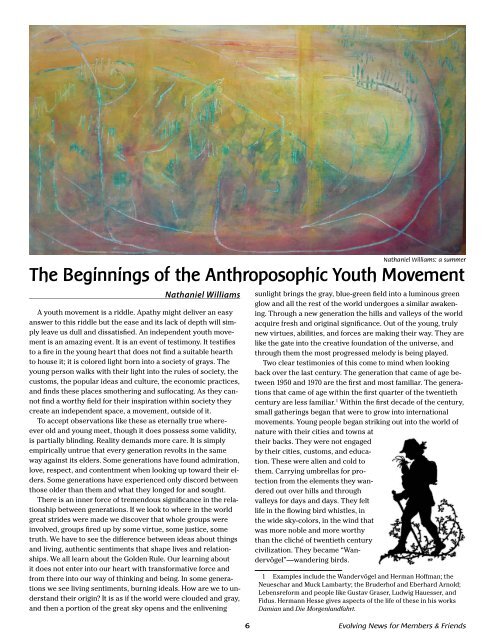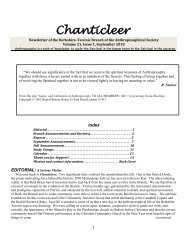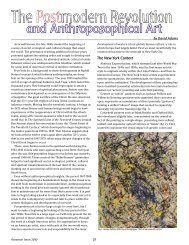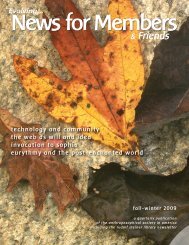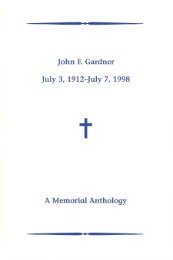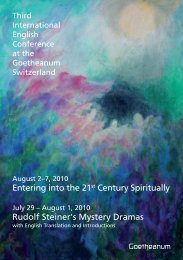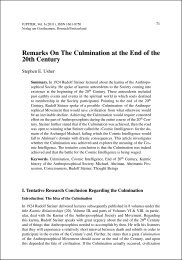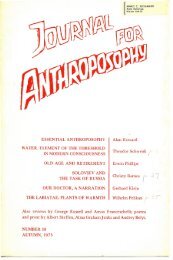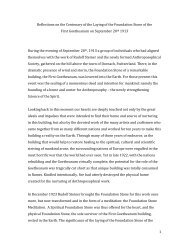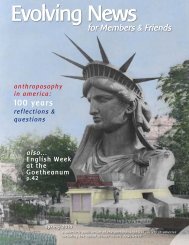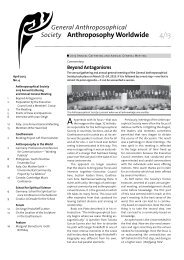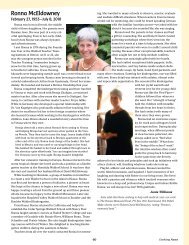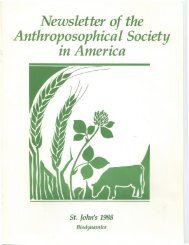Nathaniel Williams: a summerThe Beg<strong>in</strong>n<strong>in</strong>gs of the Anthroposophic Youth MovementNathaniel WilliamsA youth movement is a riddle. Apathy might deliver an easyanswer to this riddle but the ease and its lack of depth will simplyleave us dull and dissatisfied. An <strong>in</strong>dependent youth movementis an amaz<strong>in</strong>g event. It is an event of testimony. It testifiesto a fire <strong>in</strong> the young heart that does not f<strong>in</strong>d a suitable hearthto house it; it is colored light born <strong>in</strong>to a society of grays. Theyoung person walks with their light <strong>in</strong>to the rules of society, thecustoms, the popular ideas and culture, the economic practices,and f<strong>in</strong>ds these places smother<strong>in</strong>g and suffocat<strong>in</strong>g. As they cannotf<strong>in</strong>d a worthy field for their <strong>in</strong>spiration with<strong>in</strong> society theycreate an <strong>in</strong>dependent space, a movement, outside of it.To accept observations like these as eternally true whereeverold and young meet, though it does possess some validity,is partially bl<strong>in</strong>d<strong>in</strong>g. Reality demands more care. It is simplyempirically untrue that every generation revolts <strong>in</strong> the sameway aga<strong>in</strong>st its elders. Some generations have found admiration,love, respect, and contentment when look<strong>in</strong>g up toward their elders.Some generations have experienced only discord betweenthose older than them and what they longed for and sought.There is an <strong>in</strong>ner force of tremendous significance <strong>in</strong> the relationshipbetween generations. If we look to where <strong>in</strong> the worldgreat strides were made we discover that whole groups were<strong>in</strong>volved, groups fired up by some virtue, some justice, sometruth. We have to see the difference between ideas about th<strong>in</strong>gsand liv<strong>in</strong>g, authentic sentiments that shape lives and relationships.We all learn about the Golden Rule. Our learn<strong>in</strong>g aboutit does not enter <strong>in</strong>to our heart with transformative force andfrom there <strong>in</strong>to our way of th<strong>in</strong>k<strong>in</strong>g and be<strong>in</strong>g. In some generationswe see liv<strong>in</strong>g sentiments, burn<strong>in</strong>g ideals. How are we to understandtheir orig<strong>in</strong>? It is as if the world were clouded and gray,and then a portion of the great sky opens and the enliven<strong>in</strong>gsunlight br<strong>in</strong>gs the gray, blue-green field <strong>in</strong>to a lum<strong>in</strong>ous greenglow and all the rest of the world undergoes a similar awaken<strong>in</strong>g.Through a new generation the hills and valleys of the worldacquire fresh and orig<strong>in</strong>al significance. Out of the young, trulynew virtues, abilities, and forces are mak<strong>in</strong>g their way. They arelike the gate <strong>in</strong>to the creative foundation of the universe, andthrough them the most progressed melody is be<strong>in</strong>g played.Two clear testimonies of this come to m<strong>in</strong>d when look<strong>in</strong>gback over the last century. The generation that came of age between1950 and 1970 are the first and most familiar. The generationsthat came of age with<strong>in</strong> the first quarter of the twentiethcentury are less familiar. 1 With<strong>in</strong> the first decade of the century,small gather<strong>in</strong>gs began that were to grow <strong>in</strong>to <strong>in</strong>ternationalmovements. Young people began strik<strong>in</strong>g out <strong>in</strong>to the world ofnature with their cities and towns attheir backs. They were not engagedby their cities, customs, and education.These were alien and cold tothem. Carry<strong>in</strong>g umbrellas for protectionfrom the elements they wanderedout over hills and throughvalleys for days and days. They feltlife <strong>in</strong> the flow<strong>in</strong>g bird whistles, <strong>in</strong>the wide sky-colors, <strong>in</strong> the w<strong>in</strong>d thatwas more noble and more worthythan the cliché of twentieth centurycivilization. They became “Wandervögel”—wander<strong>in</strong>gbirds.1 Examples <strong>in</strong>clude the Wandervögel and Herman Hoffman; theNeueschar and Muck Lambarty; the Bruderhof and Eberhard Arnold;Lebensreform and people like Gustav Graser, Ludwig Hauesser, andFidus. Hermann Hesse gives aspects of the life of these <strong>in</strong> his worksDamian and Die Morgenlandfahrt.6 Evolv<strong>in</strong>g News for Members & Friends
You wander<strong>in</strong>g birds <strong>in</strong> the air,<strong>in</strong> the ether-sh<strong>in</strong>e,<strong>in</strong> the sun-aroma,<strong>in</strong> blue sky-waves,I greet you as companions!I am also a wander<strong>in</strong>g bird,and my gift of songis my dearest possession.—Otto RoquetteNot everyone pursued this path. Some sought a worthy life<strong>in</strong> religious traditions, which they tried to embrace and even renew.Others tried to f<strong>in</strong>d someth<strong>in</strong>g worthy by reach<strong>in</strong>g far back<strong>in</strong>to past civilizations and mythologies. Everyone had <strong>in</strong> commonthe search <strong>in</strong> other places, other times, other sett<strong>in</strong>gs thanthose offered by their elders, where they could live a human lifethat satisfied them. Their elders could not <strong>in</strong>spire respect andadmiration <strong>in</strong> them. Their elders testified to their impotencethrough their creation of the brutal <strong>in</strong>sanity that was the FirstWorld War. Many of the young witnessed this testimony fromthe blood-spewn trenches. Who could be <strong>in</strong>spired by such acivilization?Many <strong>in</strong> this young generation became aware of an elderwho sparked some wonder and admiration <strong>in</strong> them. He waswell known and controversial. He tirelessly traveled throughoutEurope, lectur<strong>in</strong>g, and was <strong>in</strong>volved <strong>in</strong> a number of huge creativeprojects: the creation of the large work of art <strong>in</strong> Dornach,Switzerland, called the Goetheanum; the movement for a newsocial order; and leadership of a new and <strong>in</strong>novative school <strong>in</strong>Stuttgart called the Waldorf School. He was not just dream<strong>in</strong>g.He thoroughly understood the current state of civilization andculture and yet he did not f<strong>in</strong>d it sufficient. The culture thatthe older generation was so proud of, and <strong>in</strong> their pride wereentrenched <strong>in</strong>, was materialistic natural science, it’s methods,results, and technologies. This man acknowledged the carefulobservations and the many fruitful <strong>in</strong>sights and technologiesthis science made possible, yet he <strong>in</strong>sisted that the rema<strong>in</strong><strong>in</strong>gforces and mysteries of the universe had to be pursued aswell. He ma<strong>in</strong>ta<strong>in</strong>ed that so long as science only recognizedone realm of the world as significant and existent, then such ascience would yield illusion <strong>in</strong>stead of truth, s<strong>in</strong>ce it overlookedgreat portions of reality. He worked to reveal the need to furtherthe knowable, and what is even more important, he actually pursuedthis further<strong>in</strong>g. He developed a spiritual science, which hecame to call anthroposophy, by pursu<strong>in</strong>g the <strong>in</strong>spirations thatpersonalities like Goethe and Fichte had pursued and develop<strong>in</strong>gthem to a new level of maturity. Besides this he recognizedsignificance <strong>in</strong> many spiritual movements of his time, such asthe Theosophical movement and Freemasonry. He worked withand with<strong>in</strong> them. This man was Rudolf Ste<strong>in</strong>er.So the younger generation met an elder who was totally athome <strong>in</strong> his time, yet also po<strong>in</strong>ted to its illusions and failuresand developed ways forward. Many of his contemporariesmay have viewed him as an eccentric stand<strong>in</strong>g at the fr<strong>in</strong>ges ofsociety, but this was far from the truth. He stood fully with<strong>in</strong>his time, as his work shows anyone will<strong>in</strong>g to do some research.Among the younger generation to witness him at this po<strong>in</strong>twere such people as Arvia MacKaye, Karl Ege, Ernst Lehrs,Maria Roeschl, Lili Kolisko, and Herbert Hahn. Many of the realcarry<strong>in</strong>g forces of the first Waldorf School were from this younggeneration.The new melody the younger generation heard <strong>in</strong> their heartsfound a harmonious resonance <strong>in</strong> an elder. It was not a simpleharmony, either. Through Rudolf Ste<strong>in</strong>er they heard the maturityof their songs, an enrichment and articulation they hadonly div<strong>in</strong>ed. Many came to discover that the <strong>in</strong>spiration theyfelt <strong>in</strong> themselves was also speak<strong>in</strong>g through Rudolf Ste<strong>in</strong>er andanthroposophy. Here they found an elder from whom they couldstrive to learn <strong>in</strong> total freedom. They felt they might not needan isolated and separate youth movement as they had foundan elder who was creative, active, and <strong>in</strong> relationships that correspondedwith their <strong>in</strong>ner ideals.Rudolf Ste<strong>in</strong>er gave a course for a group of these youngpeople 2 . He saw the fire <strong>in</strong> them as tremendously significant.It was a new fire. He saw <strong>in</strong> the danc<strong>in</strong>g flames the sparks thatwould illum<strong>in</strong>e a new age. He had been fueled by the same light<strong>in</strong> his work to develop anthroposophy. I know that it is difficulttoday to take such <strong>in</strong>sights as <strong>in</strong>dicat<strong>in</strong>g real facts; all the same,that is what is meant here. That there are real spiritual forces atwork <strong>in</strong> our lives is a strange idea for most people today. Whatis strange is grant<strong>in</strong>g them the right to be as real as our skeletalsystem. By “real” I do not mean spatial extension and mass;these measurements are not the only way to validate positiveexistence. These forces have particular qualities, and there areforces that can br<strong>in</strong>g our heart to jump <strong>in</strong> enthusiasm and to seethe spirit and soul <strong>in</strong> the world as well as <strong>in</strong> other people, just asthere are forces that humble us and fill us with receptivity andopenness. Despite the unpopularity of this idea, it is an idea thatcorresponds with reality, and is an <strong>in</strong>sight and experience thatanyone can achieve given <strong>in</strong>terest and a will<strong>in</strong>gness to pursue it.Yet the young who were try<strong>in</strong>g to f<strong>in</strong>d their way <strong>in</strong>to the meet<strong>in</strong>gsand activities of older anthroposophists were very disappo<strong>in</strong>ted.At times they met meek bookishness, contemplativerestra<strong>in</strong>t, and extreme arrogance. They wanted to see the firethey recognized <strong>in</strong> Rudolf Ste<strong>in</strong>er <strong>in</strong> all other anthroposophists.Many elders did not live up to this ideal. The young wanted todeny the elders’ version of anthroposophy. Some older anthroposophistsfound the younger generation to be superficial, anuisance at times, and a distraction from all the important workthat had to be done. Rudolf Ste<strong>in</strong>er encouraged the elders todist<strong>in</strong>guish between the essential and <strong>in</strong>essential and to maketime for the younger people. He criticized their obsession withtheir work and their overlook<strong>in</strong>g the importance of humanrelationships. He turned with some severity to the young, whowere beg<strong>in</strong>n<strong>in</strong>g to see themselves as the true anthroposophists,and struck down this vanity. He warned them that anthroposophywas for everyone, for old and young each <strong>in</strong> their own way.He revealed it to them as a power affect<strong>in</strong>g humans <strong>in</strong> manyconditions, <strong>in</strong> many different ways. He encouraged them tohave compassion for the older generation who could not freethemselves from the grayness of the n<strong>in</strong>eteenth century. He toldthem that they possessed enthusiasm through their youth, butthey would grow old and dull like everyone else if they did notactively awaken the spirit <strong>in</strong> themselves through work<strong>in</strong>g withanthroposophy. He po<strong>in</strong>ted out that their <strong>in</strong>st<strong>in</strong>ctive, physiologicalyouthfulness would wane and that only by establish<strong>in</strong>g a2 Rudolf Ste<strong>in</strong>er, Becom<strong>in</strong>g the Archangel Michael’s Companions(formerly The Younger Generation). Ste<strong>in</strong>erBooks, 2007.Spr<strong>in</strong>g-Summer 20097


